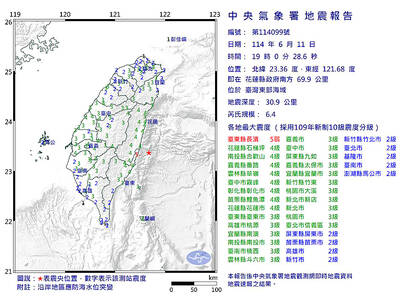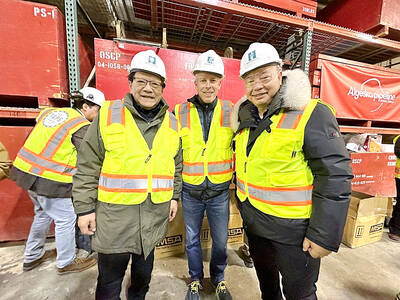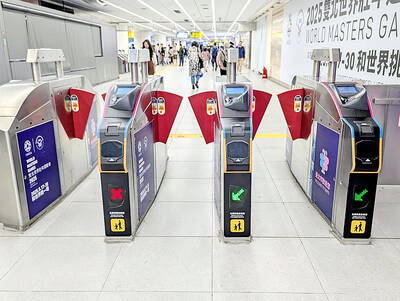The Ministry of Transportation and Communications lashed out yesterday at a news report by Asahi Shimbun on Sunday that criticized the Taiwan High Speed Rail Co (THSRC) for using Japanese technology but hiring French drivers for the trains.
Deputy Minister of Transportation Ho Nuan-hsuan (
"I can even give you a table comparing the times when Japanese media published [negative] reports on Taiwan's Shinkansen and the times when THSRC achieved milestones," Ho said.
Ho gave several examples, including coverage of sinkages in Yunlin and Miaoli Counties when THSRC was about to test-drive the rail system at 200kph.
Ho said that Central Japan Railway Co (also known as JR Central), which is in charge of the technical transfer and maintenance training for Taiwan's high speed rail system, was reluctant to allow Taiwanese drivers to operate the trains.
"What is the point when [Taiwanese drivers] can only observe and can never operate the trains themselves?" Ho said.
Ho said that THSRC must carry on, and cannot afford a delay of another two to three years simply because the drivers lack training.
Ho also suggested that the lack of trained drivers was the main reason why the Japanese media had claimed that the THSRC might have to postpone its official launch again.
"We have to survive," Ho said. "We will bear the loss if we cannot operate as scheduled."
Ho added that the majority of the bullet train tracks had been constructed by the Japanese companies, except the Taipei-Banciao (
"I wonder what the report was trying to say," Ho said, "Is the joke on Japan or on Taiwan?"
Ho said that he supported THSRC's decision to take a "tough stand" by hiring European drivers to resolve the issue of personnel training.
"Taiwan will be working with JR on a long-term basis, not the Europeans. I hope that THSRC and JR will resume their cooperation as in the past," he said.
Ho also reiterated yesterday that the bullet train will be launched as planned in October.

A magnitude 6.4 earthquake struck off the coast of Hualien County in eastern Taiwan at 7pm yesterday, the Central Weather Administration (CWA) said. The epicenter of the temblor was at sea, about 69.9km south of Hualien County Hall, at a depth of 30.9km, it said. There were no immediate reports of damage resulting from the quake. The earthquake’s intensity, which gauges the actual effect of a temblor, was highest in Taitung County’s Changbin Township (長濱), where it measured 5 on Taiwan’s seven-tier intensity scale. The quake also measured an intensity of 4 in Hualien, Nantou, Chiayi, Yunlin, Changhua and Miaoli counties, as well as

Credit departments of farmers’ and fishers’ associations blocked a total of more than NT$180 million (US$6.01 million) from being lost to scams last year, National Police Agency (NPA) data showed. The Agricultural Finance Agency (AFA) said last week that staff of farmers’ and fishers’ associations’ credit departments are required to implement fraud prevention measures when they serve clients at the counter. They would ask clients about personal financial management activities whenever they suspect there might be a fraud situation, and would immediately report the incident to local authorities, which would send police officers to the site to help, it said. NPA data showed

ENERGY RESILIENCE: Although Alaska is open for investments, Taiwan is sourcing its gas from the Middle East, and the sea routes carry risks, Ho Cheng-hui said US government officials’ high-profile reception of a Taiwanese representative at the Alaska Sustainable Energy Conference indicated the emergence of an Indo-Pacific energy resilience alliance, an academic said. Presidential Office Secretary-General Pan Men-an (潘孟安) attended the conference in Alaska on Thursday last week at the invitation of the US government. Pan visited oil and gas facilities with senior US officials, including US Secretary of the Interior Doug Burgum, US Secretary of Energy Chris Wright, Alaska Governor Mike Dunleavy and US Senator Daniel Sullivan. Pan attending the conference on behalf of President William Lai (賴清德) shows a significant elevation in diplomatic representation,

The Taipei MRT is to begin accepting mobile payment services in the fall, Taipei Rapid Transit Corp said on Saturday. When the company finishes the installation of new payment units at ticketing gates in October, MRT passengers can use credit cards, Apple Pay, Google Pay and Samsung Pay, the operator said. In addition, the MRT would also provide QR payment codes — which would be compatible with Line Pay, Jkopay, iPass Money, PXPay Plus, EasyWallet, iCash Pay, Taiwan Pay and Taishin Pay — to access the railway system. Currently, passengers can access the Taipei MRT by buying a single-journey token or using EasyCard,